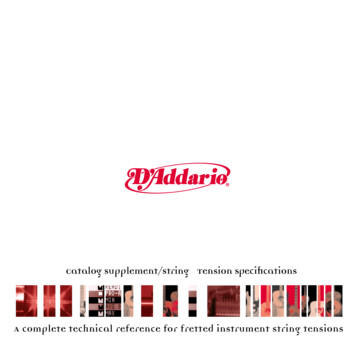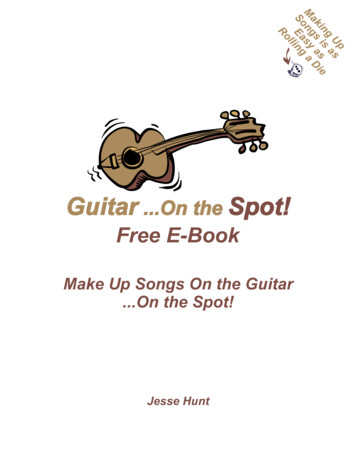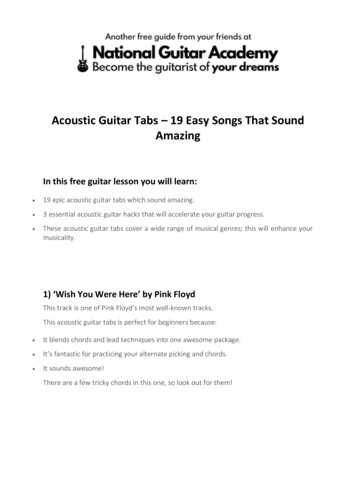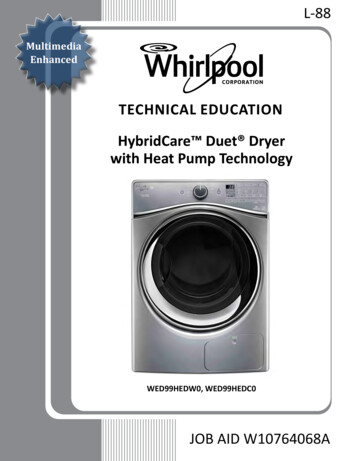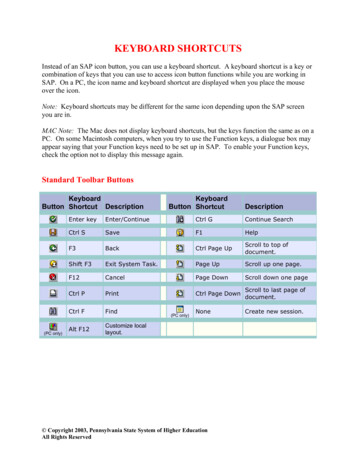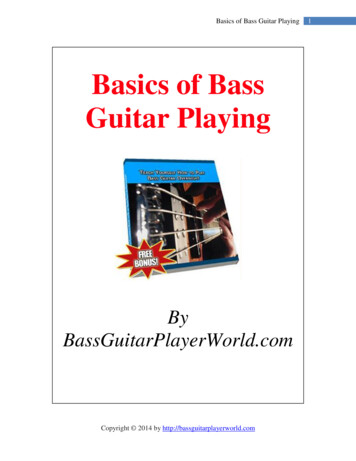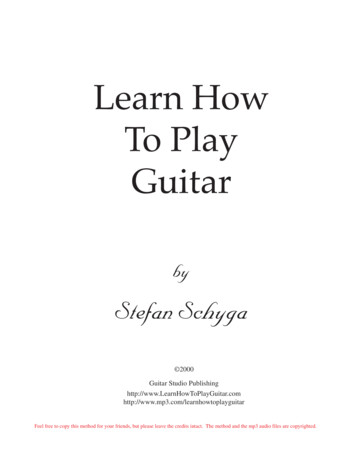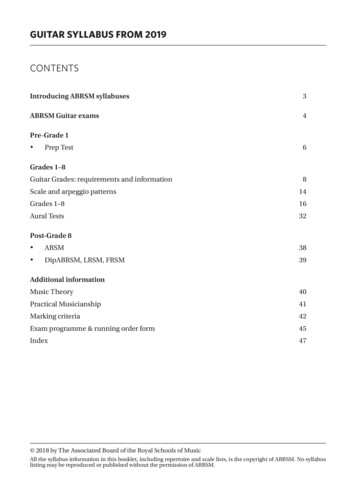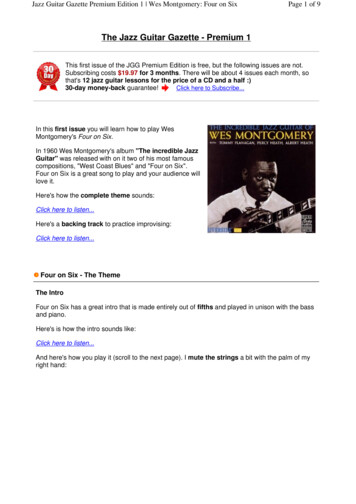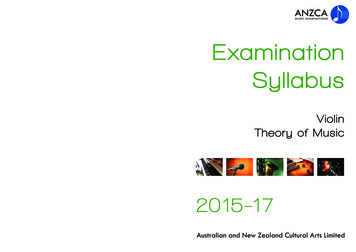
Transcription
Also available:Pianoforte/KeyboardPianoforte DuetGuitar/Bass/MandolinDrum inationSyllabusViolinTheory of Music2015-17Australian and New Zealand Cultural Arts LimitedA.B.N. 12 006 692 039 I.R.D. 74 370 878P.O. Box 70, Greensborough Vic. 3088 AustraliaPhone: (03) 9434 7640 Fax: (03) 9434 1291Email: admin@anzca.com Web: www.anzca.com.auAustralian and New Zealand Cultural Arts Limited
1ForewordAustralian and New Zealand Cultural Arts Limited is a non-profit examiningbody of the performing arts. It was formed in 1983, in response to a growingneed among private music teachers for an examination system catering fora greater diversity of musical styles. In recognizing the vital role modernmusic plays, especially among the young, ANZCA set out to design itssyllabuses to cater for both classical and modern streams.ANZCA hopes to stimulate and excite musicians by providing syllabuses thatare at once refreshing and educational. All aspects of the syllabuses, includingscales, aural tests, sight reading and improvisation, have been arranged in alogical sequential order, with due regard to the educational merit underlyingeach requirement.Modern and classical syllabuses are currently available for pianoforte, organ,guitar, singing, trumpet and flute, as well as contemporary syllabuses forkeyboard, mandolin, bass, ukulele, drum kit, trombone, clarinet, saxophone,accordion, recorder, strings and theory of music. Group examinations areoffered for Classical Singing (Grade 2), Recorder (Preliminary to Grade 3),String Quartet (four levels) and Piano Duet (six levels).A Performance syllabus option is also available for most instruments, inwhich examinations are assessed on the performance of four pieces only.There are no other requirements or requisites, and modern and classicalworks from standard ANZCA lists may be freely mixed.The syllabus lists have been carefully compiled, with great attention beingpaid to setting interesting and musical pieces, especially at the junior levels.In most instruments, a Free Choice option allows students to perform amodern or classical work not listed in the syllabus, including originalcompositions. In modern syllabuses, students are encouraged to embellishand improvise on pieces.ANZCA has been at the forefront in developing modern stream examinationsin all instruments, and will continue to work on improving and extendingboth the classical and modern syllabuses.
2ContentsBoard Directors, Representatives. . . . . . . . . . . . . . . . . . . . . . . . . . . . . . . . . . 3Examiners . . . . . . . . . . . . . . . . . . . . . . . . . . . . . . . . . . . . . . . . . . . . . . . . . . . . . 5Notes regarding Examination Areas / Series, Regulations, etc. . . . . . . . . . . 6Theory Syllabus . . . . . . . . . . . . . . . . . . . . . . . . . . . . . . . . . . . . . . . . . . . . . . 8General Information: Violin . . . . . . . . . . . . . . . . . . . . . . . . . . . . . . . . . . . . . 20Sight Reading . . . . . . . . . . . . . . . . . . . . . . . . . . . . . . . . . . . . . . . . . . . . . . . . . 22Aural Tests . . . . . . . . . . . . . . . . . . . . . . . . . . . . . . . . . . . . . . . . . . . . . . . . . . . 23General Knowledge . . . . . . . . . . . . . . . . . . . . . . . . . . . . . . . . . . . . . . . . . . . . 26Violin Syllabus . . . . . . . . . . . . . . . . . . . . . . . . . . . . . . . . . . . . . . . . . . . . . . 30General Information: Violin Performance Syllabus . . . . . . . . . . . . . . . . . 59String Quartet Syllabus . . . . . . . . . . . . . . . . . . . . . . . . . . . . . . . . . . . . . . . 61
3General InformationREGISTERED OFFICE:A.B.N. 12 006 692 039Postal Address: P.O. Box 70, Greensborough, Vic., 3088 AustraliaOffice: 4/14 Yan Yean Road, Diamond Creek, Vic., 3089 AustraliaRegistered Office: 24 Albion Crescent, Greensborough, Vic., 3088 AustraliaPhone: (03) 9434 7640Fax: (03) 9434 1291Email: admin@anzca.comWeb: www.anzca.com.auANZCA Limitedwww.youtube.com/user/ANZCALimitedOffice hours: 8.30 am to 4.30 pm, Monday to Friday.GENERAL MANAGER:Mr Tony BetrosBOARD DIRECTORS:BARRY ARCHIBALDChairpersonMAUREEN GRIEVEVice ChairpersonMAUREEN MILTON OAMDOUGLAS MCGREGORWENDY BRENTNALL-WOODJENNY BROWNCommunity MemberNew Zealand MemberINTERNATIONAL REPRESENTATIVES:New ZealandMRS JENNY BROWN, TaupoPH.(07) 378 4068Malaysia/Brunei/SingaporeMS AUDREY CHIN, Time & Tune, Kota KinabaluPH.012 828 5111IndonesiaPT. SINTANADA MUSIC EDUCATION, JakartaPH.(21) 451 6762ThailandMS PANADDA HONGSAKUL,Castle Intercontinental Music Co. Ltd., BangkokPH.(02) 712 7940AUSTRALIAN STATE AND TERRITORY REPRESENTATIVES:A.C.T.GISELLE & KIERAN ROBERTS, WanniassaPH.0412 982 708N.S.W.MR MATT DALZIEL, Pennant HillsPH.1300 131 852N.T.MR ANDREW ARTHUR, NightcliffQld.CONTACT THE ANZCA OFFICES.A.MRS LESLEY GENTILIN, Port LincolnTas.CONTACT THE ANZCA OFFICEW.A.MRS TRACY MEYN, EatonPH.(08) 8985 5111PH.0428 160 606PH.0408 933 219
4LOCAL REPRESENTATIVES:N.S.W.Qld.SHARYN MACDONALD, MacleanPH.(02) 6645 4315JULIE POTTS, Newcastle areaPH.(02) 4982 7120ANNE RUSSELL, Port MacquariePH.(02) 6581 0123CYNTHIA DELANEY, Mackay – Central/North regionPH.0407 035 963PAM GARVEN, RockhamptonPH.(07) 4926 6710DOROTHY MCCORMACK, Gold CoastPH.(07) 5531 7343MICHAELEEM MONSOUR, NoosavillePH.(07) 5449 7526JEANINE TEGG, TownsvillePH.(07) 4772 2287NICOLE TOBIN-DONNELLY, CairnsPH.(07) 4034 2219Tas.LEONIE WATSON-PETERS, DevonportPH.(03) 6424 7378Vic.SALLY BELLINGHAM, BendigoPH.0417 558 379JOHN BREHAUT, BairnsdalePH.(03) 5152 6250HEATHER MILES, WangarattaPH.0403 884 348ANTHONY MONEA, GeelongPH.(03) 5229 6889DOROTHY ROGERS, MilduraPH.(03) 5023 3624W.A.SUSAN LEWIS, BusseltonPH.(08) 9754 2501New ZealandDENISE DORE, Dunedin – South Island RepresentativePH.(03) 488 0679DIANE DRAVITSKI, New PlymouthPH.(06) 757 8511MIRIAM DU FEU, TaurangaPH.(07) 578 6479JOCELYN LUDLOW, HastingsPH.(06) 876 6470MARGARET RANSLEY, Hamilton/Waikato regionPH.(07) 843 6156CAROL WARD, TrenthamPH.(04) 971 7229
5EXAMINERS:New South WalesMitzi Bee, A.Mus.A., Dip.Mus.Ed.(Sydney Con.)Heather Boyd, B.Mus., FTCL, LTCL, A.Mus.A.Sandra Conwell,Cert.M.T.(NSW Con.), ADMT(NSW Con.), ATCL(T)Sr. Duchesne Lavin,L.Mus.A., FTCL, LTCL, FLCM, M.Mus.Ed., LAGM, MIMTKerrie O’Connor-Brown, FTCL, LTCL, ATCL, A.Mus.A.Mark Quarmby, B.Mus., F.Dip.A., LTCL, A.Mus.A.Suzanne Stein, BCA(Mus.Perf.)Robert Woodward, B.Mus.(Hons.)QueenslandRonlyn Adams, B.Mus.(Hons.)Denise Collins, ATCL, A.T.Mus.A., Ex.Cert.Music Guild, FACMRegis Danillon, M.Mus., ARCM(Hons.)Cynthia Delaney, ATDA, A.T.Mus.A., Cert. Kodaly Ed.Caryn Eastman Roberts,B.Ed., Dip.Mus.T., Dip.T., LTCL, ATCL, A.Mus.A., A.Mus.TCLPatricia Gough, ATCL(T)Karen Henderson, B.Mus., LYMFJack Ingram,M.Mus., FATD, FTCL, LTCL(Hons), A.Mus.A.(Piano), A.Mus.A.(Trumpet)David LovelandDorothy McCormack,FTCL, LTCL, M.Mus., B.Mus.Ed., A.Mus.A., FFCSME, DSMEGillian McNamee, M.Ed., B.Mus., RULM, LTCLMelissa Mitchell, B.Ed.(F.E.T.)Michaeleem Monsour, A.Mus.A., FTCL, LTCL, ATCLJeanine Tegg, B.Mus., FTCL, LTCL, L.Mus.A., A.Mus.A.Kerry Vann, Ph.D., M.Mus., B.Mus.(Hons.), B.A., Dip.Ed., FTCL,LTCL, ATCL, A.Mus.TCL, A.Mus.A.Catherine Yu, M.Mus.(UQ), B.Mus.(Perf.), L.Mus.A., A.Mus.A.South AustraliaJennifer Campbell, BMBS, B.Mus.(Perf.)(Hons.), L.Mus.A.,A.Mus.A., Cert.Mus.(Accomp.), MIMTSamantha White, B.Mus., Grad.Dip.Ed.VictoriaBarry Archibald, B.A., B.Ed., M.Ed., DIPT, AAGM, MACEMargaret Baker, A.Mus.A., MIMTDarryl Barron,Ad.Cert., B.Mus.Perf., B.Teach., A.Dip.A., LTCL, FTCLAnthony Betros, F.Dip.A., A.Dip.A., MIMTDavid BoothJohn Brehaut, B.Mus.Ed., TPTC, JMC(Yamaha)Wendy Brentnall-Wood,B.Mus.Ed.(Melb.), A.Mus.A., MIMTStefanie Carter, B.Mus.(Melb.), L.Dip.A., A.Dip.A., L.Mus.A.Melissa Condello, B.Ed., B.Mus.Belinda Cook, B.Mus.(Melb.)Andrew Craggs,B.A.(La Trobe), A.Dip.A.(Piano), A.Dip.A.(Organ)Anne Credlin, B.Mus., M.Ed., A.Mus.A., MACEEmmanuel Cuschieri, B.Ed., A.Dip.A.(Hons.)Abe Cytrynowski, B.A.(Melb.), Dip.Ed.(Melb.), A.Mus.A.Gianna Galea, B.Mus.(Melb.), A.Mus.A., PCTCLMay Gavin, T.Mus.A., L.Mus.A., A.Mus.A.Maureen Grieve, AUA(Dip.Mus.), A.Mus.A., MIMTBrendan HainsHelene Hatton, M.Mus.(Perf.)Douglas McGregor, B.Sc., Dip.Ed.June McLean, B.A.(La Trobe), ALCMMaureen Milton, OAM, A.Dip.A., A.Mus.A., MIMTIvor Morgan,Mus.Bac.(Melb.), B.Ed.(Mon.), TPTC, STPC, MACE, MIMTMark Murphy, A.Dip.A.Michelle Nelson,B.Mus.(Hons.)(Melb.), L.Mus.A., A.Dip.A., A.Mus.A.Haydn Reeder,Ph.D., B.Mus., Dip.Comp.(Vienna Acad.), M.A.(La Trobe)David Reichman, B.Sc.(Hons.), M.Mus.(Phila.)Dorothy Rogers, A.Mus.A.John Siranidis, B.Ed.Michael Smith, B.Ed.(Mus.), A.Mus.A., MIMTGreg Stone,A.Dip.A., LLCM, ALCM, DipLCM, LLCM(TD), ALCM(TD), DipLCM(TD)David Urquhart-Jones, GTCL, LTCL, M.Mus.(Michigan)Kevin Williams, B.Mus., A.Mus.A., Dip.Ed., B.Sci.Diana Wu, B.Mus.Perf.(Melb.), Grad.Dip.Mus.Tech.(La Trobe),B.Teach.(Hons.)(Melb.), M.Ed.(Melb.), A.Mus.A.(Piano), A.Mus.A.(Flute)TasmaniaGlenn Clark, LCMD, FCMD, L.Dip.A.Western AustraliaValorie Guldbaek, A.Dip.A., PCMC, Grad.Cert.
6EXAMINERS:(Continued)Western Australia (Continued)Michelle McConnell, Cert.Mus., ADPA(WA Con.), A.Mus.A.Jennifer Regterschot, DMTGloria UnderwoodNew ZealandJudith Field, LTCL, A.Mus.TCL, ATCL, FIRMTLynda Moorcroft, L.Mus.A. (Piano), L.Mus.A.(Singing), B.Mus.,Dip.Ed., DOAMT, Diplom Stimmbildung (Vienna), Ph.D.(Sydney)Sharlene Penman,B.Mus., LTCL, ATCL, L.Mus.TCL, A.Mus.TCL., LRSM, AIRMTMargaret Ransley, ATCL, AIRMTCarol Ward, LTCL, ATCL, AIRMTMalaysiaMisa Yamamoto, B.Mus.Perf.(Honours), L.Mus.A., A.Mus.A.EXAMINATION AREAS, SERIESANDREGULATIONS:Details of examination areas, series, fees and regulations are listed in the currentExamination Information and Handbook manual. This is sent, in January, to allteachers who have entered candidates in the preceding year, and also to teacherscontacting ANZCA for the first time.Teachers are reminded that in signing the examination entry form, they are agreeingto abide by ANZCA regulations.The Examination Information and Handbook manual is available, free of charge, fromthe ANZCA office by request on ph. 03 9434 7640, fax 03 9434 1291 or emailadmin@anzca.com .
ADVERTISEMENT
8THEORY OF MUSICTHEORY OF MUSIC – TERMINOLOGY The following is a list of the terms required for each grade. The meanings given are those whichthe Board considers to be satisfactory English equivalents.PreliminaryCrescendo (cresc.): gradually becoming louder.Diminuendo (dim.): gradually becoming softer.Forte ( f ): loud.Legato: smooth and connected.Mezzo forte ( mf ): moderately loud.Mezzo piano ( mp ): moderately soft.Moderato: at a moderate speed.Piano ( p ): softRitenuto ( riten. or rit. ): immediately slower or held back.Staccato: short and detached.Grade OneAdagio: slow.Allegro: fast and lively.Andante: at an easy walking pace.A tempo: return to former speed.Fine: finish.Fortissimo ( ff ): very loud.Mezzo staccato: moderately short and detached.Pianissimo ( pp ): very soft.Rallentando ( rall. ): gradually becoming slower.Ritardando ( ritard. or rit. ): gradually becoming slower.Grade TwoAccelerando ( accel. ): gradually becoming faster.Allegretto: moderately fast.Cantabile: in a singing style.Da capo: from the beginning.Dolce: sweetly.Marcato: marked.Molto: very.Poco: little.Staccatissimo: very short and detached.Tenuto: held.Grade ThreeAllargando: becoming broader.Animato: animated.Con moto: with movement.Dal segno: from the sign.Forte-piano ( fp ): loud then immediately soft.Leggiero: lightly.Lento: slowly.Loco: at normal pitch (after an 8va sign).Main droite (M.D.): right hand.Main gauche (M.G.): left hand.
THEORY OF MUSICGrade Three(Continued)Grade FourGrade FiveMeno mosso: less movement.Piu mosso: more movement.Presto: very fast.Sempre: always.Sforzando ( sf ): a strong accent.Arco: with the bow.Assai: very.Calando: getting softer and slower.Grave: slow and solemn.Grazioso: gracefully.Largo: broadly.Morendo: dying away.Pesante: heavily.Pizzicato: pluck the string with the finger.Prestissimo: as fast as possible.Quasi: almost.Risoluto: resolute.Scherzando: in a light playful manner.Senza: without.Smorzando: dying away.Sostenuto: sustained.Subito: suddenly.Tranquillo: calmly.Tre corde: release the soft pedal.Una corda: with the soft pedal.Attacca: go on at once.Ad libitum: at pleasure.Cantando: in a singing style.Con anima: with animation.Con brio: with brilliance.Con forza: with force.Dolente: sadly.Giocoso: gaily.Largamente: broadly.L’istesso tempo: at the same speed.Maestoso: majestically.Non troppo: not too much.Perdendosi: fading away.Piacevole: pleasantly.Rubato: with some freedom in the time.Sotto voce: softly, in an undertone.Stringendo: pressing on faster.Tempo commodo: at a convenient speed.Tempo giusto: at a consistent speed.9
10THEORY OF MUSICPRELIMINARYDuration: 45 minutesANZCA publication relevant to this level: ANZCA Music Theory – Pathway to PreliminaryPitch Treble or G clef, bass or F clef.Names of the lines and spaces, middle C and the notes B and D either side of Middle C.The sharp, flat and natural.Scales Recognition and writing of C major and A natural minor, ascending and descending, oneoctave only.Positioning of tones and semitones (C major only); the writing of scale degree numbers underthe notes.Triads Writing of the tonic triad in root position of C major and A minor.Time and Duration Recognition and writing of the following values: semibreve, minim and crotchet(notes and rests), and dotted minim (note only). Division of notes into those of lesser value.Recognition and writing of the time signatures 2/4, 3/4 and 4/4, and the number of beats per bar.Terminology As listed on page 8.Signs Recognition, writing and explanation of the following signs: brace; bar line; double barline; crescendo; diminuendo; legato slur; tie; staccato; staff or stave.GRADE ONEDuration: 1 hourANZCA publication relevant to this level: ANZCA Music Theory – Pathway to Grade OnePitch Names of the lines and spaces, to one leger line above and below each stave, includingaccidentals.Keys and Scales Recognition and writing of the scales of C, G and F major and A harmonicminor, one octave only. Their key signatures, positioning of the tones and semitones and thewriting of degree numbers under notes.Time and Duration Recognition and writing of values as set for the previous grade, with theinclusion of the dotted crotchet (note only), quaver (note and rest) and whole bar of silence.Time signatures as for previous grade with the inclusion of the common time sign ( c).Understanding of the terms simple duple, simple triple and simple quadruple.Intervals Recognition and writing (by number only) of the diatonic intervals, above the tonicnote, in the keys set for this grade; tones and semitones. Treble and bass staves.Triads Recognition and writing of the root position tonic triad in the keys set for this grade.Treble and bass staves.Transposition Transposition of a simple melody to one of the major keys set for this grade.Terminology As listed on page 8, in addition to those set for the previous grade.Signs As for Preliminary, with the addition of mezzo staccato and accent.
11THEORY OF MUSICGRADE TWODuration: 1½ hoursANZCA publication relevant to this level: ANZCA Music Theory – Pathway to Grade TwoPitch As for the previous grades, but including two leger lines above or below the stave.Keys and Scales As for the previous grades, with the addition of D and B flat major and E andD harmonic minor.Time and Duration As for the previous grades, with the addition of the dotted crotchet rest,semiquaver note and rest, and triplets using quaver or crotchet notes. Time signatures will include2/2 (cut common time, C) and 6/8. Understanding of the terms compound duple and triplet.Intervals Recognition and writing of the diatonic intervals, above the tonic note, in the keysset for this grade; major, minor and perfect only. Treble and bass staves.Triads The root position tonic triad in the keys specified for this grade. Treble and bass.Melody Writing To divide a couplet of words into measured beats using upright lines.Transposition Transposition of a melody to one of the major keys specified for this grade.Terminology As listed on page 8, in addition to those set for the previous grades.Signs As for the previous grades, with the addition of pause, repeat, staccatissimo and tenuto.GRADE THREEDuration: 2 hoursANZCA publication relevant to this level: ANZCA Music Theory – Pathway to Grade ThreePitch As for the previous grades, but including all leger lines, and simple enharmonic change.Keys and Scales As for the previous grades, with the addition of E, A and E flat major; G andB harmonic minor; A, E and D melodic minor. Technical degree names.Time and Duration As for the previous grades, with the addition of the dotted semibreve,dotted quaver, dotted semiquaver, demisemiquaver, and duplets and triplets using any noteor rest value. Time signatures will include 3/2, 3/8 and 9/8. Understanding of the termscompound triple and duplet.Intervals As for the previous grades, with the addition of the keys set for this grade, andintervals above any note within the key (including diminished and augmented intervals).Recognition and writing of diatonic and chromatic semitones.Triads Tonic, subdominant and dominant triads, in root position and first inversion, of themajor and harmonic minor scales set for this grade.Melody Writing (One of the following will be set)(a) To write a suitable rhythmic pattern to a given couplet of words.(b) To write a melody to a given four-bar rhythm and harmonic progression (in Romannumerals), in a major key up to two sharps or flats. Harmony will consist of tonic, subdominantand dominant triads. The melody should be within a voice range of the candidate’s choice, andinclude unessential notes.
12GRADE THREETHEORY OF MUSIC(Continued)Harmony Writing and recognition of the perfect and plagal cadences in four-part vocal style,in the keys set for this grade.Transposition Transposition of a melody to one of the keys set for this grade. Accidentals maybe included.Terminology As listed on pages 8 and 9, in addition to those set for all previous grades.Signs As for the previous grades, with the addition of M.M., 8va, appoggiatura, acciaccatura,double sharp and double flat.General Knowledge To show an understanding of anacrusis, sequence, and binary and ternaryform. The voice compasses of soprano, alto, tenor and bass.GRADE FOURDuration: 3 hoursANZCA publications relevant to this level: ANZCA Music Theory – Pathway to Grade Four From Blues to Bop and Beyond. – A. Cytrynowski This examination includes Classical Stream and Modern Stream questions. Students shouldprepare one stream only.Pitch As for Grade Three.Keys and Scales As for the previous grades, with the addition of B and A flat major; F sharp,C sharp, C and F harmonic and melodic minor; G and B melodic minor.Time and Duration As for the previous grades, with the addition of the breve and all dottedand double-dotted values. Time signatures will include 4/2, 4/8 and 12/8. Understanding of theterm compound quadruple. Recognition and writing of syncopation.Intervals As for the previous grades, with the addition of the keys set for this grade, andinversion of all intervals.Chords Writing and recognition of all triads in root position and inversions in the keys set forthis grade. Root position of the dominant seventh chord, and the usual resolution of the thirdand seventh of this chord. Vocal style to be used.Melody Writing To write a melody to a given eight-bar rhythm and harmonic progression (inRoman numerals), in a major or minor key up to two sharps or flats. The melody should bewithin a voice range of the candidate’s choice, and must include unessential notes. Modulationis not required.Harmony Recognition and writing of the four principal cadences in four-part vocal style, in thekeys set for this grade. Knowledge of suitable chords to precede these cadences.The harmonization of a figured bass in four-part vocal style, using the following vocabulary:Major keys: I, ii, IV, V, vi; Ib, iib, IVb, Vb, vib, viib*.Minor keys: i, iv, V, VI;ib, ivb, Vb, VIb, viib*.*viib should be used in the context of I-viib-Ib and Ib-viib-I progressions (major and minor).Terms used in harmony, together with a knowledge of common faults to be avoided.
THEORY OF MUSICGRADE FOUR13(Continued)Modulation Recognition in melodies of modulation to the dominant, relative major or relativeminor keys.Analysis To analyse the chord structure of a given passage, using the harmonic vocabulary setfor this grade. Vocal or instrumental style may be given.Transposition Transposition of a melody, which includes accidentals, to one of the keys setfor this grade.Ornaments Writing in full the appoggiatura and acciaccatura (minim and crotchet value only).Terminology As listed on page 9, in addition to those set for all previous grades.Signs As for the previous grades, with the addition of trill, turn, mordent and arpeggio chord.Classical StreamTwo-partTo add a part, note against note in vocal style, above or below a given passage. Up to eightbars in a major or minor key will be set.General KnowledgeTo demonstrate an understanding of the style and features of the Baroque and Classicalperiods, including reference to the following for each: time frame; characteristics; common forms, including the main sections (but not modulations); common instrumentation, both solo and ensemble/orchestral; knowledge of the main composers of these periods. References to works must be limitedto the following composers: Baroque – J. S. Bach, Handel, Purcell;Classical – Mozart, Beethoven (early), Haydn.An understanding of rondo form.A knowledge of the following instruments: violin, viola, cello and double bass.Modern StreamMelodic DecorationA simple eight-bar melody in a major or minor key with chord symbols will be given. Thecandidate must rewrite this melody, adding notes to create an interesting melodic lineconsistent with the chord progression. A single-note melody line only will be required.General KnowledgeThe history and elements (eg. rhythm, form, style, instrumentation, etc.) of Ragtime and NewOrleans styles up to 1920. A knowledge of the foremost exponents (and their well-knownworks where applicable) of each style, such as (but not limited to) the following:Ragtime – Scott Joplin, James Scott, Joseph Lamb;New Orleans – Louis Armstrong, Joe “King” Oliver, Johnny Dodds, Edward “Kid” Ory,Jelly Roll Morton.An understanding of rondo form and the common Twelve Bar Blues form.A knowledge of the following instruments: pianoforte, cornet, trombone and clarinet.
14THEORY OF MUSICGRADE FIVEDuration: 3 hoursANZCA publications relevant to this level: ANZCA Music Theory – Pathway to Grade Five From Blues to Bop and Beyond. – A. Cytrynowski This examination includes Classical Stream and Modern Stream questions. Students shouldprepare one stream only.Pitch As for Grade Four.Keys and Scales Recognition and writing of all major and minor (harmonic and melodic) scalesand their key signatures. The harmonic chromatic scale.Time and Duration As for the previous grades, with the addition of 5/4, 5/8, 7/4 and 7/8.Intervals Writing and recognition of all diatonic and chromatic intervals, including invertedand compound.Transposition Transposition of a melody to the C clef (tenor and alto).Ornaments As for the previous grade, with the addition of the following: trill, turn andmordent (crotchet value only in fast and moderate speeds); appoggiatura on a dotted minim.Chords As for the previous grades, but including second inversion tonic (Ic), subdominant (IVc)and dominant (Vc) chords, plus suitable preceding and following chords. Major or minor keys.Dominant seventh in root position and inversions, resolving to the tonic chord (in root positionor inversion). Major or minor keys.Melody Writing To write a melody to a given verse, in a major or minor key up to three sharpsor flats. The words must be written below the notes. The melody should be within a voicerange of the candidate’s choice, and must include unessential notes.Harmony Harmonization of a melody or bass in four-part vocal style, using the vocabulary:Major keys: I, ii, IV, V, vi; Ib, iib, IVb, Vb, vib, viib; Ic.Minor keys: i, iv, V, VI;ib, iib, ivb, Vb, VIb, viib; ic.Unaccented passing and auxiliary notes, and the Tierce de Picardie.Terms used in harmony, together with a knowledge of common faults to be avoided.ModulationRecognition in melodies and cadences of modulation to the dominant,subdominant and to the relative major or minor.Analysis To analyse the chord structure of a given passage, using the vocabulary given for thisgrade. Vocal or instrumental style may be given.Terminology As listed on page 9, in addition to those set for all previous grades.Signs As for the previous grades, with the addition of repetition of a whole bar or a group ofnotes, and tremolo.Classical StreamTwo-partTo add a part in vocal style above or below a given eight-bar passage, using two notes to onein simple time, or three notes to one in compound time. Key may be major or minor.
15THEORY OF MUSICGRADE FIVE(Continued)Classical Stream (Continued)General KnowledgeTo demonstrate an understanding of the style and features of the Romantic period, includingreference to the following: time frame; external influences; characteristics; common forms, including some detail in relation to the main sections and modulations,and compositional devices; common instrumentation, both solo and ensemble/orchestral; knowledge of the main composers of this period. References to works must be limited tothe following composers: Chopin, Grieg, Schumann, Mendelssohn.Instruments: general knowledge of the woodwind instruments of the orchestra.Modern StreamMelodic DecorationAs for Grade Four, but the candidate must also add notes below the embellished melodic lineto create a second part.General KnowledgeThe history and elements of Blues, Boogie, Spiritual and Gospel Song, and Jazz up to 1930.A knowledge of the foremost exponents (and their well-known works where applicable) ofeach style, such as (but not limited to) the following:Blues – Gertrude “Ma” Rainey, Bessie Smith, Charley Patton, Robert Johnson;Boogie – Jimmy Yancey, Clarence “Pinetop” Smith;Spiritual/Gospel Song – Mahalia Jackson;Jazz – as for Grade Four New Orleans, plus: Bix Beiderbecke, Gene Krupa, Duke Ellington,Benny Goodman.Instruments: general knowledge of the trumpet, guitar, saxophone and string bass.GRADE SIXDuration: 3 hoursANZCA publications relevant to this level: ANZCA Music Theory – Pathway to Grade Six From Blues to Bop and Beyond. – A. Cytrynowski This examination includes Classical Stream and Modern Stream questions. Students shouldprepare one stream only.Harmony Harmonization of a simple melody or unfigured bass in four-part vocal style, usingthe vocabulary (major and minor keys):I, II, III, IV, V, VI; Ib, IIb, IIIb, IVb, Vb, VIb, VIIb; Ic, IVc, Vc; V 7, V 7b, V 7c, V 7d.Accented and unaccented passing notes and auxiliary notes; single suspensions.Modulations to the dominant, subdominant and relative major or minor.
16THEORY OF MUSICGRADE SIX(Continued)Melody Writing (One of the following)(a) To write a melody to a four-line stanza, in a major or minor key up to four sharps or flats.The words must be written below the notes. The melody should be within a voice range of thecandidate’s choice, and include modulation (minimum of eight bars).(b) To complete a four-phrase melody of which the first two bars are given (minimum ofsixteen bars), in a major or minor key up to four sharps or flats. The melody should be withina voice range suitable to the given opening, and modulations are expected.Classical StreamTwo-partTo write a part above or below a given part in simple contrapuntal keyboard style. Passing,auxiliary, changing and subsidiary notes should be used wherever suitable.Set WorkA symphony or part thereof will be set for study, from which the candidate will be askedgeneral questions. Knowledge of main themes and orchestration will be required.2015-17 – HAYDN, F. J. Symphony no. 103 (The Drum Roll), 1st and 2nd movements.General KnowledgeTo demonstrate an understanding of the styles and features of the post-Romantic/20thCentury period, including reference to the following: time frame; external influences; characteristics; common forms, including considerable detail of structure and compositional devices; common instrumentation, both solo and ensemble/orchestral; knowledge of the diverse range of composers of this period. References to works must belimited to the following composers: Early – Debussy, Strauss, Rachmaninov;Later – Stravinsky, Schönberg, Bartók, Britten.A knowledge of the following brass and percussion instruments of the symphony orchestra:horn, trumpet, trombone, tuba, kettle drums, xylophone, glockenspiel and cymbals.Modern StreamAccompanimentTo add a modern pianoforte accompaniment to a melody of up to twelve bars.Jazz AnalysisTo analyse the harmony, using roman numerals, of a jazz composition of up to sixteen bars.Questions on the form, rhythm and style of the composition may be set.General KnowledgeThe history and elements of the principal Jazz and Latin styles up to 1960. A knowledge of theforemost exponents (and their well-known works where applicable) of each style, such as(but not limited to) the following:Jazz – Glenn Miller, Miles Davis, Charlie Parker, Dave Brubeck, Lennie Tristano.Latin – Tito Puente, Frank Grillo (“Machito”), A. C. Jobim, Stan Kenton.General knowledge of the main percussion instruments of these styles.
17THEORY OF MUSICGRADE SEVENDuration: 3 hours per paperPart One: September sitting only. Part Two: May sitting only.Pass mark: 75% average over both parts, with no one part having a mark lower than 70%.PART I: Harmony and CounterpointVocabulary as given for the previous grade, with the following inclusions:Diminished triad
Syllabus Violin Theory of Music Also available: Pianoforte/Keyboard Pianoforte Duet Guitar/Bass/Mandolin Drum Kit Singing Brass Woodwind Accordion Organ/Keyboard. 1 Foreword Australian and New Zealand Cultural Arts Limited is a non-profit examining body of the perform

